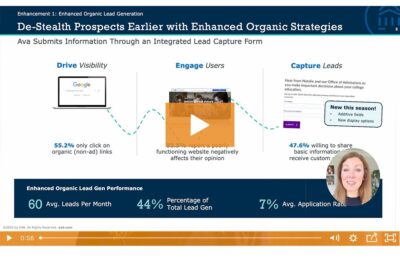Despite the uncertainties of the pandemic, graduate enrollment increased at its fastest rates in nearly a decade during 2020 and 2021, outpacing industry projections. But with this opportunity also came new and evolving challenges, including:
- Increased pressure to grow graduate revenue amid accelerated declines in undergraduate enrollment
- A heightened imperative to rapidly increase diversity, equity, and access
- Staffing shortages and team burnout
- Changing student preferences and behaviors during the pandemic
Pressure is mounting for graduate enrollment leaders
Prior to the pandemic, graduate enrollment was outpacing undergraduate enrollment. COVID-19 only exacerbated this trend. Given this disparity, it is no wonder that nearly half of surveyed graduate enrollment leaders said their institutions increasingly rely on graduate enrollment to compensate for shortfalls in undergraduate enrollment.
Although total graduate enrollment expanded during the pandemic, that growth was concentrated in a subset of institutions. Thirty-four percent of institutions experienced an enrollment decline of at least 2.5% from 2019 to 2020. This trend is consistent with the findings from our survey of graduate enrollment leaders. In 2020, 27% of survey respondents said they did not meet their enrollment goals. This number only worsened in 2021, when 34% of survey respondents reported they did not meet their enrollment goals.
Pressures facing graduate enrollment leaders
Graduate enrollment leaders are placing a growing emphasis on marketing
To meet growing graduate enrollment goals, most survey respondents are amplifying marketing and recruitment efforts. Notably, more graduate enrollment leaders increased marketing efforts in 2021 (66%) than in 2020 (51%). However, fewer survey respondents met their enrollment goals in 2021 than in 2020.
This suggests that expanded marketing efforts did not necessarily have the enrollment impact survey respondents desired. While the volume of marketing activity is key to strong recruitment campaigns and enrollment growth, it is critical that enrollment leaders prioritize marketing strategy rooted in data rather than sheer volume.
Marketing and enrollment tactics of your peers
Heightened expectations mean increased stress for enrollment teams
Given the pressures outlined above, it is no wonder that survey respondents reported high stress levels, both professionally and personally. This remained the case even as the pandemic began to wane post-vaccine. Forty-three percent of respondents said they are experiencing more stress in 2022 than in 2021-suggesting that factors beyond the uncertainty and challenges of COVID-19 are contributing to enrollment leaders’ stress.
Survey respondents identified “additional staff and filling vacant positions” as the top way their institution could alleviate work-related stress. Sixty-one percent of surveyed enrollment leaders had one or more unfilled positions in their department. At the same time, 40% of respondents said they are considering leaving their role, exacerbating an already challenging talent churn across higher ed.
“Our institution continues to try to implement major structural changes and there have been huge leadership changes and styles to manage in the midst of this. Slowing the pace of change might help.”
Survey respondent Stress facing enrollment leaders


